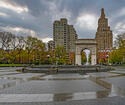New Suburbanism advances a set of ideas to deepen the conversation about the synergistic relationship between core areas, suburbs, and rural areas. It challenges the prevailing ideology that density is a virtue. It appeals for an update of planning practice, given the pandemic push and new technology pull. A set of actionable ideas referred to as the Elements of New Suburbanism are presented. read more »
Suburbs
What COVID Hath Wrought
Glenn Ellmers’s analysis of COVID and Trump represents a classic, and effective, account of the situation from the perspective of declining liberty and adherence to traditional values. read more »
- Login to post comments
More Evidence That Young Americans Are Not Attracted to Dense Cities
As COVID-19 restrictions lift and cities attempt to stem the population and commercial losses they have sustained over the past two years, many urbanists are still banking that the historic, well-documented trend of young adults flocking to big cities read more »
- Login to post comments
America is Quietly Reinventing Itself
The future shape of post-Covid America is beginning to emerge. As demographic trends and surveys indicate, the pandemic has helped accelerate large, epochal changes in the nation’s geography. read more »
- Login to post comments
Americans Prefer Single-Family Neighborhoods
Many surveys have found that the vast majority of Americans, including Millennials, prefer or aspire to live in single-family homes. But surveys rarely ask whether they prefer that single-family home to be in a low-density neighborhood or if they would mind living next to a bunch of apartment buildings. read more »
- Login to post comments
All Major Metropolitan Area Growth Outside Urban Core: Latest Year
The latest City Sector Model analysis of major metropolitan areas shows that dispersion accelerated in 2020 during the period covered by the American community survey 2020 five- year survey (2016 to 2020). The American Community Survey collects a five year sample that covers virtually all geographies in the United States. The new 2016-2020 sample has an “middle year” of 2018.
The City Sector Model read more »
- Login to post comments
Net Domestic Migration: Shift to From Larger Metros to Smaller Areas Accelerates
Late in the last decade, domestic migrants began moving to smaller metropolitan areas and micropolitan areas (CBSA’s) as domestic migration to the larger metropolitan areas fell. The trend was covered in “Domestic Migration to Dispersion Accelerates (Even Before Covid).” The trend has continued, especially in the year ended July 1, 2021, according to Census Bureau estimates. read more »
- Login to post comments
Huge Spike in Domestic Migration from Urban Cores
Net domestic migration losses spiked perhaps as never before in the pandemic year of 2021 among urban core counties --- the counties that contain the urban cores read more »
The Biggest Cities Are Past Their Prime
As the centers of media and political discourse, large cities, notably New York, have a unique ability to promote themselves, asserting that dense, core urban areas own the future. Yet in reality, even during good times, and well before the pandemic, Americans have been headed, in increasing numbers, to suburbs, exurbs and to smaller cities. read more »
- Login to post comments
Census 2021 Estimates: Increased Dispersion
According to the US Census Bureau, the year ended July 1, 2021, grew the slowest of any year on record. The driving factor was the Covid-19 pandemic, which increased morbidity and substantially reduced the natural increase of population (births minus deaths). read more »






















